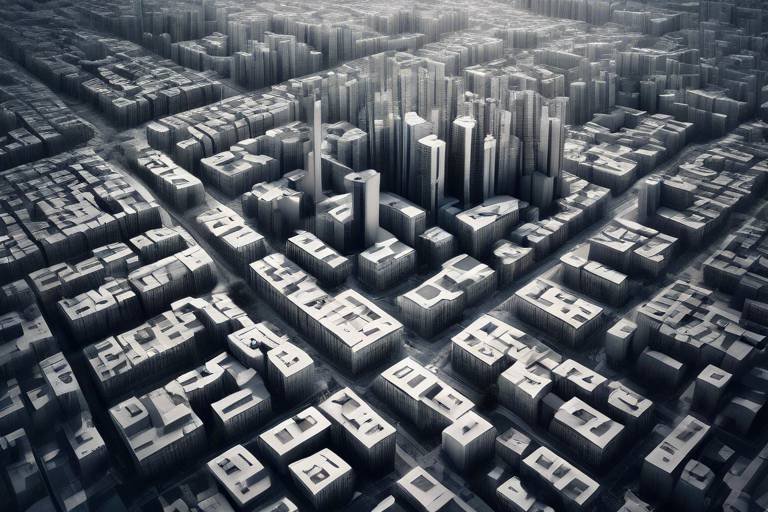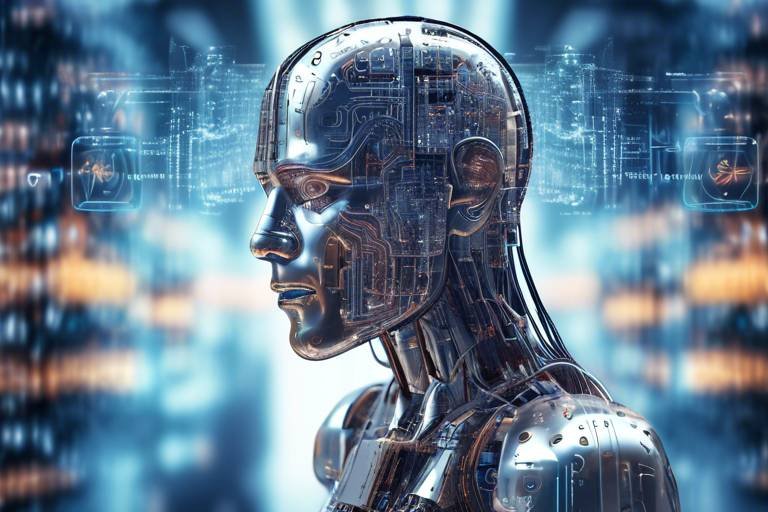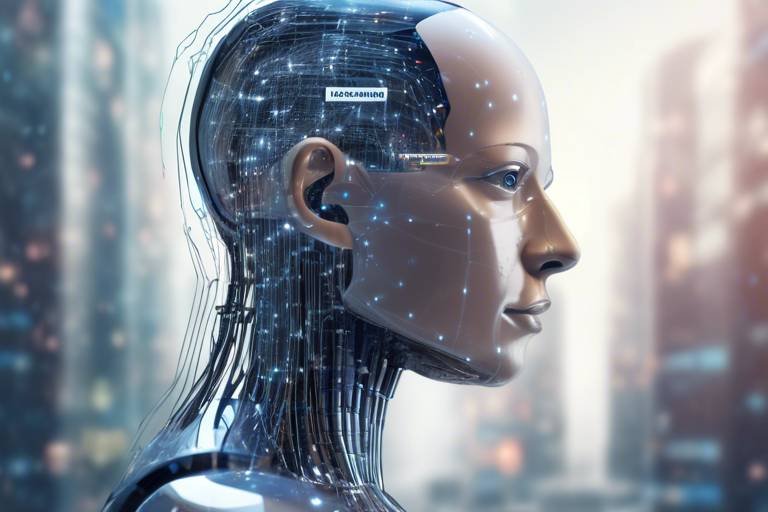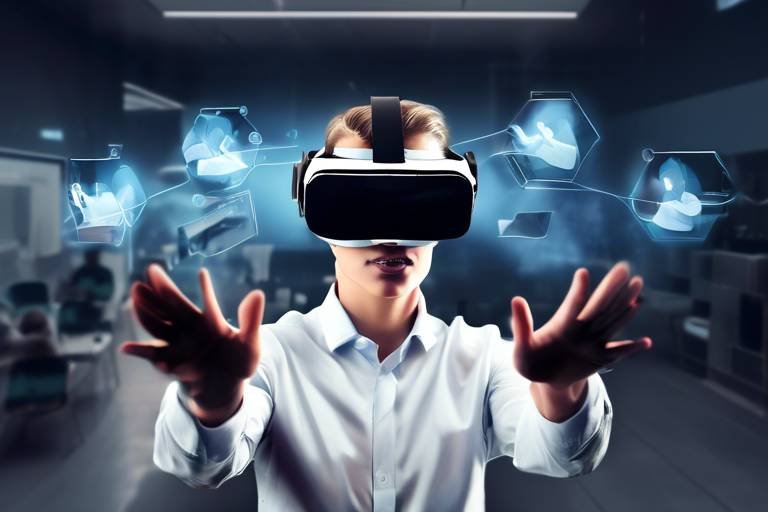The Role of AI in Urban Planning
In an era where cities are expanding at an unprecedented rate, the role of artificial intelligence (AI) in urban planning has become not just beneficial, but essential. Imagine a bustling city where traffic flows smoothly, energy consumption is minimized, and public spaces are designed with the community's needs in mind. This is not a distant dream; it is a reality being shaped by AI technologies. By leveraging innovative tools and data-driven insights, urban planners are transforming how cities function, making them more livable, efficient, and sustainable.
AI empowers planners to sift through mountains of data at lightning speed, offering insights that were previously unimaginable. For instance, consider the vast amounts of information generated by city sensors, social media, and public records. AI algorithms can analyze this data to uncover patterns and trends, informing decisions that enhance urban design and infrastructure planning. This capability allows planners to be proactive rather than reactive, addressing potential issues before they escalate into significant problems.
Moreover, the integration of AI into urban planning is not merely about crunching numbers; it’s about enhancing the quality of life for residents. Imagine a city where public transportation is not only efficient but also tailored to the needs of its users. AI technologies facilitate the development of smart infrastructure, optimizing resource use and improving the functionality of urban systems such as transportation and utilities. This optimization leads to a seamless experience for residents, making daily commutes less stressful and more efficient.
As we delve deeper into the specifics, we uncover various applications of AI in urban planning, including predictive modeling, traffic management solutions, and energy efficiency initiatives. Each of these areas plays a pivotal role in shaping the urban landscape of the future. For instance, predictive modeling allows urban planners to forecast growth patterns, enabling them to make informed decisions about land use and resource management. Similarly, AI-driven traffic management solutions can analyze real-time data to alleviate congestion, creating a smoother flow of vehicles and pedestrians alike.
In addition to these technical advancements, AI also enhances community engagement. By collecting and analyzing public feedback, AI-driven tools ensure that urban development aligns with the desires and needs of residents. This participatory approach fosters a sense of ownership among community members and leads to more successful urban projects.
As we continue to explore the multifaceted role of AI in urban planning, it becomes evident that the future of our cities is being reshaped by these advanced technologies. From optimizing resource allocation to conducting environmental impact assessments, AI is paving the way for sustainable urban development that prioritizes both the environment and the well-being of its inhabitants.
- What is the primary benefit of using AI in urban planning?
AI enhances decision-making processes, allowing urban planners to analyze data quickly and efficiently, leading to better urban design and infrastructure planning. - How does AI improve traffic management in cities?
AI algorithms analyze real-time traffic patterns to develop solutions that reduce congestion and improve mobility. - Can AI help in community engagement?
Yes, AI-driven tools collect public feedback, ensuring urban development aligns with the needs and preferences of residents. - What role does AI play in sustainability?
AI assists in assessing the environmental impact of urban projects and helps develop strategies for climate resilience and energy efficiency.

AI-Driven Data Analysis
Artificial intelligence is changing the game when it comes to urban planning, and one of the most significant contributions is its ability to perform data analysis at lightning speed. Imagine sifting through mountains of data—traffic patterns, population demographics, environmental factors—all in a matter of seconds. This is precisely what AI does, and it provides urban planners with insights that were previously unimaginable. By leveraging AI-driven data analysis, planners can make decisions that are not only informed but also tailored to the unique needs of their cities.
With traditional methods, analyzing data could take weeks, if not months. However, AI algorithms can process vast datasets in real-time, identifying trends and correlations that can significantly influence urban design and infrastructure planning. For instance, when planners want to understand traffic flow, AI can analyze data from various sources, such as GPS signals, social media posts, and sensor networks, to create comprehensive traffic models. This allows for a more effective approach to managing congestion and improving overall mobility.
Moreover, AI can help in identifying patterns that might not be immediately obvious to human analysts. For example, it can reveal how certain events, like a local festival or a sports game, impact traffic and public transport usage. This kind of analysis is invaluable for city planners who need to anticipate changes in urban dynamics. By understanding these patterns, planners can implement strategies that enhance the overall efficiency of urban systems.
Another key aspect of AI-driven data analysis is its ability to facilitate predictive analytics. By analyzing historical data, AI can forecast future trends in urban growth and resource needs. This predictive capability is crucial for effective land use and resource management, ensuring that cities can adapt to changing circumstances. For instance, if AI predicts a surge in population in a particular area, planners can proactively allocate resources and develop infrastructure to accommodate this growth.
In conclusion, AI-driven data analysis is not just a technological advancement; it's a transformative force in urban planning. By harnessing the power of AI, urban planners can make data-driven decisions that enhance the quality of life for residents while optimizing resource allocation. The future of urban planning is bright, and AI is at the forefront of this evolution.
- How does AI improve urban planning?
AI enhances urban planning by providing rapid data analysis, predictive modeling, and insights that inform better decision-making. - What types of data can AI analyze for urban planning?
AI can analyze various types of data, including traffic patterns, demographic information, environmental data, and social media trends. - Can AI predict future urban growth?
Yes, AI can use historical data to forecast future trends in urban growth and resource needs, allowing for proactive planning.

Smart Infrastructure Development
In today's rapidly evolving urban landscapes, is becoming a game changer. Imagine a city where everything is interconnected, from the roads we drive on to the energy that powers our homes. This is not just a fantasy; it's the reality that artificial intelligence is helping to create. With AI technologies at the helm, urban planners can optimize the use of resources and enhance the functionality of various urban systems. Whether it's transportation, utilities, or public services, AI is paving the way for a more efficient and sustainable urban environment.
One of the most significant advantages of integrating AI into urban infrastructure is the ability to analyze and interpret vast amounts of data. For instance, AI can monitor traffic patterns, energy consumption, and even waste management in real-time. This data-driven approach allows cities to respond dynamically to changing conditions, ensuring that resources are allocated where they are needed most. Think of it as a city that can think for itself, making adjustments on the fly to improve the quality of life for its residents.
Moreover, AI facilitates the development of smart grids and smart transportation systems. A smart grid, for example, uses AI to optimize the distribution of electricity, reducing waste and enhancing energy efficiency. Similarly, smart transportation systems can analyze traffic flow and adjust signal timings accordingly, reducing congestion and improving travel times. The result? A more fluid and responsive urban experience for everyone.
Let's take a closer look at some of the key components of smart infrastructure development:
- Real-time Monitoring: AI technologies enable continuous monitoring of infrastructure, allowing for immediate identification of issues and timely maintenance.
- Data-Driven Decision Making: By leveraging data analytics, urban planners can make informed decisions that enhance urban design and functionality.
- Resource Optimization: AI optimizes resource use, ensuring that public services are delivered efficiently and effectively.
As cities grow and evolve, the need for smart infrastructure becomes increasingly critical. Urban planners are now tasked with not only accommodating growth but also ensuring that development is sustainable. AI plays a pivotal role in this process by providing the tools needed to create resilient urban environments. With predictive modeling, planners can anticipate future needs and challenges, allowing them to implement proactive measures that benefit both the community and the environment.
In conclusion, the role of AI in smart infrastructure development is both transformative and essential. It empowers cities to become more intelligent, responsive, and adaptable to the needs of their residents. As we continue to embrace these technologies, the future of urban living looks brighter than ever.
- What is smart infrastructure? Smart infrastructure refers to systems that utilize technology, particularly AI, to enhance the efficiency and effectiveness of urban services and facilities.
- How does AI improve urban planning? AI improves urban planning by providing data-driven insights, optimizing resource allocation, and facilitating real-time monitoring of urban systems.
- What are the benefits of smart infrastructure? The benefits include improved efficiency, reduced costs, enhanced quality of life, and sustainable urban development.

Predictive Modeling
Predictive modeling is like having a crystal ball for urban planners, allowing them to foresee future trends and patterns in urban growth. Imagine being able to anticipate how a city will evolve over the next decade or two! With the help of artificial intelligence, planners can analyze historical data and current trends to create models that predict how various factors—like population growth, economic shifts, and environmental changes—will impact urban landscapes. This proactive approach enables cities to adapt swiftly to challenges, ensuring that infrastructure and services can keep pace with the changing needs of their residents.
One of the key benefits of predictive modeling is its ability to identify potential challenges before they arise. For example, by analyzing traffic patterns and population density, urban planners can forecast where congestion might occur and implement solutions ahead of time. This not only saves time and resources but also enhances the overall quality of life for residents. Think of it as a game of chess, where each move is calculated to stay several steps ahead of the opponent—in this case, the challenges that come with urbanization.
Moreover, predictive modeling can be applied across various domains within urban planning. Here are some areas where it shines:
- Land Use Planning: By predicting future land use needs, planners can allocate space for residential, commercial, and recreational areas more effectively.
- Infrastructure Development: Anticipating the need for roads, public transport, and utilities ensures that cities can grow sustainably.
- Environmental Management: Understanding how urban growth impacts local ecosystems allows for better conservation strategies.
To illustrate the power of predictive modeling, consider a city that has experienced rapid population growth. By utilizing AI-driven models, planners can visualize how this growth will affect housing demand, traffic congestion, and public service needs. For instance, a predictive model might reveal that certain neighborhoods are likely to see a 30% increase in residents over the next five years. Armed with this information, city officials can prioritize infrastructure improvements and ensure that services like schools and parks are adequately prepared for the influx.
In essence, predictive modeling transforms the way urban planning is approached. It shifts the focus from reactive measures to proactive strategies, allowing cities to thrive rather than merely survive. As we continue to embrace technology in urban development, the integration of predictive modeling will undoubtedly play a pivotal role in shaping the cities of tomorrow.
Overall, the future of urban planning is bright, thanks to the innovative capabilities of AI and predictive modeling. It's not just about building cities; it's about building smart, sustainable, and resilient communities that can adapt to the ever-changing landscape of modern life.

Traffic Management Solutions
In the bustling heart of cities, traffic congestion can feel like a never-ending nightmare. Imagine being stuck in a sea of cars, each honking in frustration, while you’re just trying to get to your destination. This is where AI-powered traffic management solutions come into play, revolutionizing how we navigate urban landscapes. By harnessing the power of artificial intelligence, urban planners and city officials can analyze real-time traffic data, leading to smarter, more efficient traffic systems that enhance mobility and reduce congestion.
At the core of these solutions are advanced algorithms that process vast amounts of data from various sources, such as traffic cameras, sensors, and GPS data from vehicles. These algorithms can identify patterns and predict traffic flows, allowing for dynamic adjustments to traffic signals and routing. For instance, during rush hour, AI can optimize traffic light timings to minimize wait times, ensuring that vehicles move smoothly through intersections. This not only reduces the time spent in traffic but also lowers emissions, contributing to a cleaner environment.
Moreover, AI can facilitate the integration of smart transportation systems that communicate with vehicles and infrastructure. Imagine a scenario where your car receives real-time updates about traffic conditions, road closures, and even the best routes to take. This level of connectivity enhances the driving experience and empowers commuters to make informed decisions on the go. The result? A significant decrease in traffic jams and improved overall traffic flow.
To illustrate the impact of AI on traffic management, consider the following table that showcases potential improvements in urban traffic conditions:
| Traffic Management Feature | Traditional Approach | AI-Driven Approach |
|---|---|---|
| Traffic Signal Timing | Fixed timing based on historical data | Dynamic adjustments based on real-time data |
| Incident Detection | Manual reporting by drivers | Automated detection using sensors and cameras |
| Route Optimization | Static maps and pre-planned routes | Real-time route adjustments based on traffic conditions |
As cities continue to grow, the need for efficient traffic management becomes more critical. AI solutions not only streamline traffic flow but also enhance safety. For example, by analyzing data on accident hotspots, AI can recommend infrastructure changes, such as adding traffic signals or improving signage, to prevent future incidents. This proactive approach to urban planning ensures that cities are not just places to live but are also designed with the safety and convenience of their residents in mind.
In conclusion, the integration of AI in traffic management is not just a technological advancement; it's a necessary evolution in how we approach urban mobility. By leveraging data-driven insights, cities can create smarter, more responsive traffic systems that cater to the needs of their citizens, ultimately leading to a more livable urban environment. So, the next time you're cruising down a smooth road or breezing through a green light, remember that AI is working tirelessly behind the scenes to make your journey more enjoyable.
- How does AI improve traffic management? AI improves traffic management by analyzing real-time data to optimize traffic signal timings, detect incidents automatically, and provide route recommendations based on current conditions.
- What are the benefits of using AI in urban planning? The benefits include enhanced decision-making, improved resource allocation, increased safety, reduced congestion, and a more sustainable urban environment.
- Can AI help reduce traffic accidents? Yes, by identifying accident-prone areas and recommending infrastructure changes, AI can significantly reduce the likelihood of traffic accidents.
- What technologies are used in AI traffic management systems? Technologies include sensors, cameras, GPS data, and machine learning algorithms that analyze traffic patterns and make real-time adjustments.

Energy Efficiency Initiatives
In today's rapidly urbanizing world, the need for energy efficiency initiatives has never been more critical. Urban areas are notorious for their high energy consumption, which not only strains resources but also contributes significantly to environmental degradation. This is where artificial intelligence (AI) steps in, acting as a game-changer in how cities approach energy management. By leveraging advanced algorithms and data analytics, AI can optimize energy usage across various sectors, ensuring that cities become more sustainable and livable.
One of the most effective applications of AI in this domain is its ability to analyze energy consumption patterns in real-time. Imagine a city where streetlights adjust their brightness based on pedestrian traffic or where buildings automatically regulate their heating and cooling systems based on occupancy. This isn't science fiction; it's the reality made possible by AI technologies. These systems not only reduce energy waste but also lower operational costs for municipalities and residents alike.
For instance, AI can predict peak energy usage times and suggest energy-saving measures to both consumers and providers. By utilizing predictive analytics, urban planners can implement strategies that encourage energy conservation during high-demand periods. This proactive approach not only alleviates pressure on the grid but also fosters a culture of sustainability among residents.
Moreover, AI-driven tools can facilitate the integration of renewable energy sources, such as solar and wind power, into the urban energy mix. By analyzing weather patterns and energy demands, AI can determine the optimal times for energy generation and storage, ensuring that cities rely less on fossil fuels. This transition is vital for achieving climate goals and promoting a healthier urban environment.
To illustrate the impact of these initiatives, consider the following table showcasing the potential energy savings from AI implementation in urban settings:
| Initiative | Potential Energy Savings (%) | Environmental Impact |
|---|---|---|
| Smart Lighting Systems | 30-50% | Reduced CO2 emissions |
| Building Automation Systems | 20-40% | Lower energy consumption |
| Renewable Energy Integration | 15-25% | Increased use of clean energy |
As cities continue to grow, the implementation of AI-driven energy efficiency initiatives will be crucial in shaping a sustainable future. The collaboration between city planners, energy providers, and technology developers is essential to harness the full potential of AI. Together, they can create intelligent urban environments that not only meet the needs of today's residents but also safeguard resources for future generations.
- What are energy efficiency initiatives? Energy efficiency initiatives are strategies and programs designed to reduce energy consumption and promote sustainable practices within urban environments.
- How does AI contribute to energy efficiency? AI contributes by analyzing data to optimize energy use, predict consumption patterns, and integrate renewable energy sources effectively.
- Can AI help in reducing costs for residents? Yes, by optimizing energy consumption and reducing waste, AI can lead to lower utility bills for residents and businesses.
- What is the future of AI in urban energy management? The future looks promising, with ongoing advancements in AI technology paving the way for smarter, more sustainable cities.

Community Engagement Tools
In today's fast-paced urban environments, community engagement has become a cornerstone of effective urban planning. It's no longer enough for planners to operate in silos; they need to actively involve residents in the decision-making process. This is where AI-driven tools come into play, revolutionizing the way urban planners gather and analyze public feedback. Imagine a world where your voice is not just heard but actively shapes the future of your city. Sounds exciting, right?
AI technologies can sift through mountains of data from various sources, including social media, surveys, and public forums, to gauge community sentiment. This means that planners can understand the needs and preferences of residents in real-time. For example, if a community is vocal about wanting more green spaces, AI can help identify suitable locations and even predict how these changes will enhance local quality of life. It's like having a digital crystal ball that not only sees the future but also listens to the present.
Moreover, these tools can facilitate interactive platforms where residents can voice their opinions, suggest improvements, and even participate in virtual town halls. This two-way communication fosters a sense of ownership among community members. When people feel that their input is valued, they are more likely to engage positively with urban development initiatives. As a result, the projects that emerge are often more aligned with the community's desires and needs.
Here are some key benefits of using AI-driven community engagement tools:
- Enhanced Feedback Collection: AI can analyze feedback quickly, allowing planners to respond to community needs more efficiently.
- Data-Driven Insights: By aggregating data from various platforms, planners can identify trends and issues that may not be immediately apparent.
- Inclusive Participation: These tools ensure that even marginalized voices are heard, promoting equity in urban planning.
In essence, community engagement tools powered by AI are not just about collecting data; they are about fostering a collaborative environment where residents and planners work hand-in-hand. The result is a more vibrant, responsive, and sustainable urban landscape. As we move forward, leveraging these innovative technologies will be essential for creating cities that truly reflect the aspirations of their inhabitants.
Q: How do AI-driven community engagement tools work?
A: These tools analyze data from various sources, such as social media and surveys, to understand public sentiment and gather feedback efficiently.
Q: Can these tools ensure that all community voices are heard?
A: Yes, AI-driven tools are designed to promote inclusivity by analyzing diverse data sources, ensuring that even marginalized voices are considered in the planning process.
Q: What are the long-term benefits of using AI in community engagement?
A: Long-term benefits include improved urban planning outcomes, greater community satisfaction, and enhanced collaboration between residents and planners.

Environmental Impact Assessment
In the realm of urban planning, understanding the environmental impact of various projects is more crucial than ever. As cities expand and evolve, the need for sustainable development practices becomes paramount. This is where artificial intelligence steps in, revolutionizing how planners assess environmental consequences. AI tools analyze extensive datasets, enabling urban planners to forecast potential ecological impacts before the first brick is laid.
Imagine trying to navigate a dense forest without a map. It would be nearly impossible to avoid obstacles or find the best path forward. Similarly, urban planners face a myriad of environmental challenges, from air quality to biodiversity loss. AI acts as a sophisticated navigational tool, providing insights that help mitigate these issues. By utilizing machine learning algorithms, planners can predict how new developments will affect local ecosystems, ensuring that urban growth does not come at the expense of our planet.
One of the standout features of AI in environmental impact assessment is its ability to process and analyze data from various sources. This includes satellite imagery, sensor data, and historical environmental records. For instance, by examining air quality data, AI can identify pollution hotspots and suggest alternative locations for new developments. This proactive approach not only minimizes harm but also fosters a healthier urban environment.
Moreover, AI facilitates the creation of dynamic simulation models that visualize potential environmental changes over time. These models allow planners to explore different scenarios, assessing the long-term impacts of their decisions. For example, if a new highway is proposed, AI can simulate its effect on local wildlife, water runoff, and even community health. This capability empowers planners to make informed choices that prioritize sustainability.
To illustrate the impact of AI in environmental assessments, consider the following table that summarizes the key benefits:
| Benefit | Description |
|---|---|
| Data Integration | Combines various data sources for comprehensive analysis. |
| Predictive Analytics | Forecasts potential environmental impacts before projects begin. |
| Scenario Simulation | Visualizes the long-term effects of urban planning decisions. |
| Sustainability Focus | Promotes eco-friendly practices in urban development. |
Furthermore, AI enhances collaboration among stakeholders, including city officials, environmentalists, and community members. Through AI-driven platforms, stakeholders can share insights and concerns, fostering an inclusive dialogue about urban development. This collaborative approach ensures that projects are not only environmentally sound but also reflect the values and needs of the community.
In conclusion, the integration of AI in environmental impact assessments represents a significant leap forward in urban planning. By harnessing the power of technology, planners can navigate the complex interplay between development and environmental stewardship, paving the way for sustainable cities that thrive in harmony with nature.
- What is environmental impact assessment?
It is a process used to evaluate the potential environmental effects of a proposed project before it is carried out. - How does AI improve environmental impact assessments?
AI enhances data analysis, predictive modeling, and stakeholder engagement, leading to more informed decision-making. - Can AI help in promoting sustainability?
Yes, AI tools can identify sustainable practices and predict the long-term impacts of urban development on the environment.

Climate Resilience Strategies
In an era where climate change is no longer a distant threat but a pressing reality, cities must adapt and become more resilient. Artificial Intelligence (AI) is stepping up to the plate, providing urban planners with the tools they need to develop effective climate resilience strategies. Imagine AI as a crystal ball that not only predicts future climate events but also offers actionable insights to mitigate their impacts. By analyzing vast datasets, AI can help cities prepare for extreme weather events, rising sea levels, and other climate-related challenges.
One of the key components of AI-driven climate resilience is its ability to process and analyze climate data in real-time. This capability allows urban planners to understand how various factors—such as population density, land use, and environmental conditions—interact with climate risks. For instance, AI can identify neighborhoods that are most vulnerable to flooding and suggest proactive measures, such as enhancing green spaces or improving drainage systems, to alleviate potential damage. This proactive approach is crucial, as it shifts the focus from reactive responses to proactive planning.
Moreover, AI can assist in simulating different climate scenarios, providing a clearer picture of potential future impacts. By utilizing predictive modeling, planners can visualize how changes in temperature, precipitation, and other climatic variables will affect urban infrastructure and ecosystems. This simulation capability is akin to playing a video game where you can test various strategies before committing to a course of action. It allows decision-makers to weigh the pros and cons of different resilience strategies, ensuring that investments are made wisely.
To illustrate the importance of these strategies, consider the following table that outlines potential climate resilience initiatives and their expected benefits:
| Initiative | Description | Expected Benefits |
|---|---|---|
| Green Roofs | Installing vegetation on rooftops to absorb rainwater and reduce heat. | Improved air quality, reduced urban heat, and enhanced biodiversity. |
| Permeable Pavements | Using materials that allow water to infiltrate, reducing runoff. | Decreased flooding risk and improved groundwater recharge. |
| Urban Forests | Planting trees to increase canopy cover and provide shade. | Lower temperatures and improved air quality. |
Additionally, community engagement is vital in developing these strategies. AI-driven tools can gather public input, helping planners understand local needs and preferences. This collaborative approach ensures that resilience strategies are not only scientifically sound but also socially acceptable. After all, the best plans are those that resonate with the community they serve.
In summary, AI is revolutionizing how cities approach climate resilience. By harnessing the power of data and predictive modeling, urban planners can create comprehensive strategies that not only prepare for climate impacts but also enhance the overall quality of life. The future of urban living depends on our ability to adapt, and with AI as a partner, cities can rise to the challenge.
- What is climate resilience? Climate resilience refers to the ability of a community to anticipate, prepare for, respond to, and recover from climate-related hazards.
- How does AI contribute to urban planning? AI contributes by analyzing large datasets, predicting future scenarios, and optimizing resource allocation, allowing for better decision-making.
- What are some examples of climate resilience strategies? Examples include green roofs, permeable pavements, and urban forests, all of which help mitigate climate impacts.
- Why is community engagement important in urban planning? Community engagement ensures that urban development aligns with the needs and preferences of residents, leading to more effective and accepted solutions.

Resource Allocation Optimization
In the bustling world of urban planning, is like the secret sauce that makes everything work seamlessly. Imagine a city as a complex machine, where every cog needs to be perfectly aligned for it to run smoothly. With the help of artificial intelligence, urban planners can now analyze and allocate resources more efficiently than ever before. But how does this actually happen? Let’s break it down.
AI technologies analyze vast datasets that include population demographics, traffic patterns, and even environmental factors. By processing this information, urban planners can identify where resources are most needed. For instance, if a neighborhood is experiencing rapid growth, AI can highlight the need for additional schools, parks, and public transport options. This kind of insight enables planners to make data-driven decisions that not only meet current demands but also anticipate future needs.
Moreover, AI can simulate various scenarios to determine the best allocation strategies. Consider this: if a city plans to build a new community center, AI can evaluate different locations based on accessibility, population density, and existing infrastructure. This predictive modeling can save cities time and money, ensuring that resources are not just thrown at problems, but are strategically placed where they’ll have the most impact.
To illustrate the effectiveness of resource allocation optimization, let’s look at a hypothetical scenario:
| Resource Type | Current Allocation | AI Recommended Allocation | Expected Outcome |
|---|---|---|---|
| Public Transport Buses | 150 | 200 | Reduced wait times and increased ridership |
| Community Parks | 10 | 15 | Improved community health and engagement |
| Schools | 25 | 35 | Better educational access for children |
This table demonstrates how AI can transform resource allocation from a reactive approach to a proactive one. By adjusting the allocation of buses, parks, and schools based on data, cities can foster a more vibrant and livable environment for their residents.
Additionally, AI can help in monitoring the effectiveness of resource allocation over time. For example, after implementing changes, planners can use AI to track usage patterns and community feedback. This continuous loop of data analysis ensures that cities remain adaptive and responsive to the needs of their populations.
In conclusion, the role of AI in optimizing resource allocation is not just a technological advancement; it’s a fundamental shift in how urban planners approach city management. By leveraging AI, cities can become more efficient, sustainable, and ultimately, more enjoyable places to live. As we continue to embrace these innovations, the potential for creating smarter, more responsive urban environments is limitless.
- What is resource allocation optimization?
Resource allocation optimization is the process of efficiently distributing resources to meet the needs of a population, often enhanced by data analysis and predictive modeling. - How does AI help in urban planning?
AI assists urban planners by analyzing large datasets to inform decisions, predict future needs, and optimize the allocation of resources, ensuring that urban environments are sustainable and functional. - Can AI predict future urban growth?
Yes, AI uses predictive modeling to forecast urban growth patterns, allowing planners to take proactive measures in land use and resource management.
Frequently Asked Questions
- What is the role of AI in urban planning?
AI plays a transformative role in urban planning by enhancing decision-making, optimizing resource allocation, and improving the overall quality of life in cities. It does this by analyzing vast amounts of data quickly, providing insights that help urban planners design better infrastructure and services.
- How does AI improve data analysis in urban planning?
AI enables urban planners to sift through and analyze massive datasets at lightning speed, uncovering trends and patterns that would be impossible to identify manually. This helps in making informed decisions that lead to more effective urban designs and infrastructure planning.
- What are smart infrastructure developments?
Smart infrastructure refers to the integration of AI technologies in urban systems such as transportation, utilities, and public services. This optimization enhances functionality and resource use, leading to more efficient and sustainable urban environments.
- Can AI predict future urban growth patterns?
Absolutely! AI uses predictive modeling to forecast urban growth patterns, allowing planners to take proactive measures in land use and resource management. This foresight is crucial for accommodating expanding populations and evolving urban needs.
- How does AI assist in traffic management?
AI algorithms analyze real-time traffic data to develop smarter traffic management solutions. By understanding traffic patterns, AI can help reduce congestion and improve mobility, making urban travel smoother for everyone.
- What role does AI play in energy efficiency?
AI contributes significantly to energy efficiency initiatives by optimizing energy consumption in buildings and urban areas. It promotes sustainable practices and helps in designing energy-efficient urban environments that are kinder to the planet.
- How does AI enhance community engagement?
AI-driven tools gather and analyze public feedback, ensuring that urban development aligns with the needs and preferences of residents. This fosters a sense of community involvement and ensures that projects reflect the voices of those who live in the area.
- What is the importance of environmental impact assessment in urban planning?
AI plays a crucial role in assessing the environmental impacts of urban projects. By analyzing data related to sustainability and ecological balance, planners can make informed decisions that promote a healthier environment for current and future generations.
- How does AI help in developing climate resilience strategies?
AI assists urban planners by analyzing climate data and predicting potential impacts on urban areas. This information is vital for developing effective adaptation measures that help cities withstand climate change and its associated challenges.
- What does resource allocation optimization mean in urban planning?
Resource allocation optimization involves using AI technologies to ensure that services and infrastructure are effectively distributed to meet the needs of growing populations. This approach helps maximize the efficiency of urban resources, ensuring that all residents have access to essential services.



















